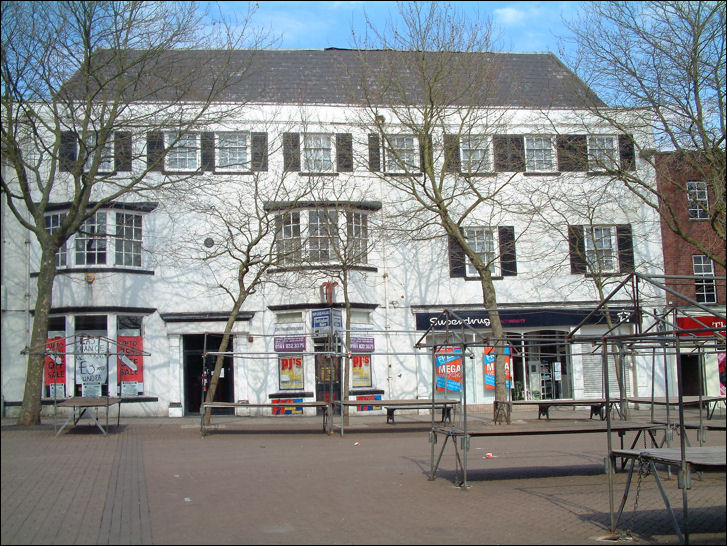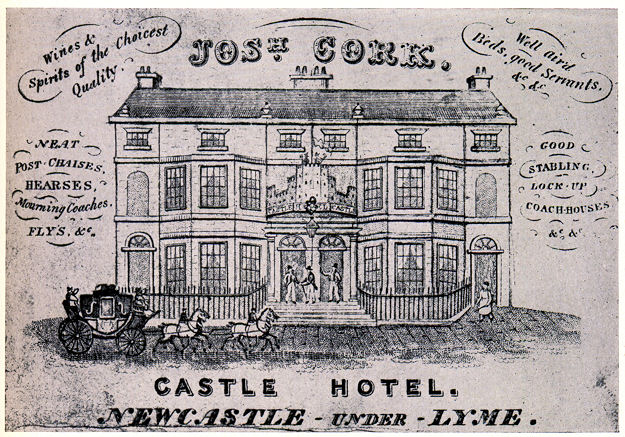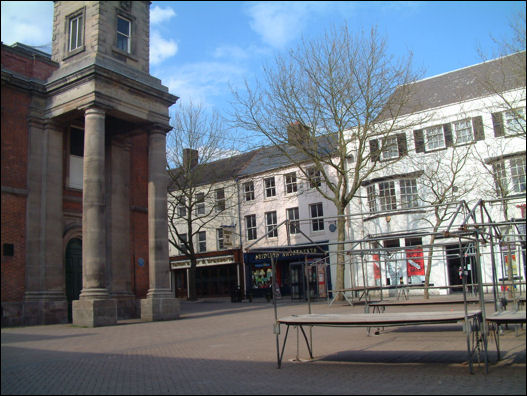|
|
|
Old Pubs of the Potteries
![]()
![]()
![]()
next: The Riley Arms, Bank Top
previous: The Golden Ball, Newcastle
contents: index of
old pubs of the Potteries
|
The
Castle Hotel, Newcastle-under-Lyme In 1851 Thomas Venables was the proprietor of the Castle Hotel, 22 High Street, Newcastle-under-Lyme.
The Castle Hotel, the only Newcastle coaching house to have survived to the present day
This view of The Castle Hotel that stood on
the High Street in Newcastle-under-Lyme was painted, signed and dated by
Reginald G. Haggar on 11th May 1969.
pictures: © Borough Museum and Art Gallery,
Newcastle under Lyme |

the previous Castle Hotel
building - April 2009
the premises occupied by Superdrug and
"PJ's - Blinds Direct"
| The
Guildhall and the Castle Hotel occupied a prime position in the busy High
Street and market place....... "The principal street is long and spacious, and many of the houses well-built. The marketplace is in the centre, and forms a fine open space, in which stands the Guild or Town Hall, raised on columns and arches, so as to form a covered market underneath. Monday is the chartered market day for corn, &c., but here is also a large Saturday market for flesh, vegetables, &c.; and no fewer than twelve annual fairs, (toll free for horses and cattle,) held on the Plough Monday, the second Monday in February, on Shrove, Easter, and Whit-Mondays; the second Mondays in May, July, August, October, and December, the third Monday in September, and the first Monday in November. That in July is called the wool fair, that in September the wakes fair, and that in November the cold fair." "The town hall, or Guild Hall, is a large brick building, with
stone pilasters, &c., in the spacious Market place, standing on pillars
and arches, which form a covered market. About twenty years ago, it was
crowned by an elegant cupola, in which are two transparent clock dials,
first illuminated with gas in 1833, by subscription. From: William White's 1851 Directory of Staffordshire |

advertisement for the coaching inn - Castle Hotel - 1839
From: A History of the County
of Stafford
|
"As the principal road
through the town High Street contained several important coaching inns by
the beginning of the 19th century. The most notable at this period was the
'Roebuck' which Lord Torrington described in 1792 as the largest inn of
the town but at the same time as 'one of the most savage, dirty alehouses'
he had ever entered. In 1839 the owner of the Castle Hotel opposite announced that he had acquired 'the horses, chaises, flys, hearses etc.' from the 'Roebuck's' late proprietor. The Castle Hotel, the only coaching house to have survived..... appears to have opened c. 1820, but the building may be a little older. The stucco front of three stories has a central doorway flanked by large two-storied bay windows. The space between the bays on the first floor was formerly occupied by an elaborate castle sign. An extension to the south of the building is of comparatively recent date." From: A History of the County of Stafford: Volume 8 (1963) |

The close proximity of the
Guildhall and the Castle Hotel
| The Guildhall is pictured
still residing over the town. The Guildhall was built in 1713, the ground
floor originally being open. The building has been altered through the
years and was a public house in 2002. The white building of the Castle Hotel can be seen to the right of the Guildhall. The Hotel was opened in around 1820 and was a popular coaching stop for traffic to and from Liverpool and Manchester, before the arrival of the railways. The building still stands having been, amongst other things, Tescos and a shoe shop. |
next: The Riley Arms, Bank Top
previous: The Golden Ball, Newcastle
contents: index of old pubs of the Potteries